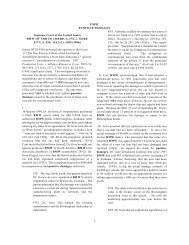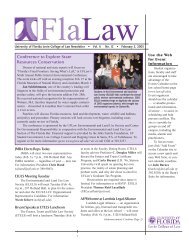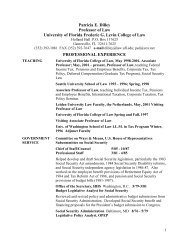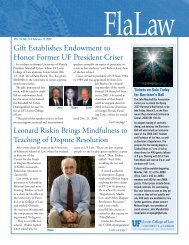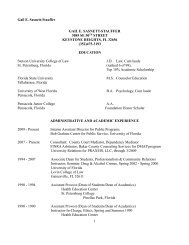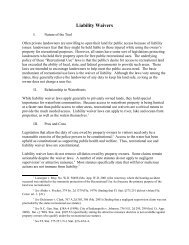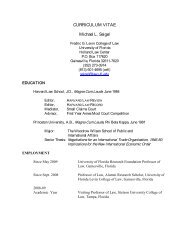The Shackling of The Shackling of Juvenile Offenders: Juvenile ...
The Shackling of The Shackling of Juvenile Offenders: Juvenile ...
The Shackling of The Shackling of Juvenile Offenders: Juvenile ...
Create successful ePaper yourself
Turn your PDF publications into a flip-book with our unique Google optimized e-Paper software.
<strong>The</strong> <strong>The</strong> <strong>Shackling</strong> <strong>Shackling</strong> <strong>of</strong><br />
<strong>of</strong><br />
<strong>Juvenile</strong> <strong>Juvenile</strong> <strong>Offenders</strong>:<br />
<strong>Offenders</strong>:<br />
<strong>Offenders</strong>:<br />
<strong>The</strong> <strong>The</strong> Debate Debate in in<br />
in<br />
<strong>Juvenile</strong> <strong>Juvenile</strong> Justice Justice Policy<br />
Policy<br />
1
Produced by<br />
Emily Banks<br />
Anna Cowan<br />
Lauren G. Fasig, Ph.D., JD<br />
Center on Children and Families<br />
University <strong>of</strong> Florida Levin College<br />
<strong>of</strong> Law<br />
2
Introduction: <strong>The</strong> <strong>Shackling</strong> <strong>of</strong> <strong>Juvenile</strong> Defendants<br />
Take the chains and shackles <strong>of</strong>f juveniles. Florida’s juveniles endure a practice worthy <strong>of</strong> chain gangs. Bar<br />
panel urges: unchain the children. 1 Headlines questioning the routine shackling <strong>of</strong> juvenile defendants<br />
have emerged in newspapers across the state. <strong>Juvenile</strong> shackling is a controversial issue in Florida<br />
and is an increasingly hot topic among public defenders and child advocacy groups throughout the<br />
United States. In most Florida circuits and counties, detained juveniles are shackled with metal<br />
handcuffs, belly chains and leg irons during all court appearances—regardless <strong>of</strong> alleged <strong>of</strong>fense or<br />
projected security risk. 2<br />
Many Florida lawyers, child advocates, and psychological experts believe shackling children<br />
is harmful and inconsistent with the rehabilitative goals <strong>of</strong> the Florida Department <strong>of</strong> <strong>Juvenile</strong> Justice<br />
(DJJ). 3 <strong>The</strong>se opponents <strong>of</strong> juvenile shackling argue that it serves only to demean and humiliate<br />
children, causing severe emotional stress and psychological harm, while serving no rehabilitative<br />
purpose. 4 A recent motion to unshackle juveniles in the 11th Circuit contends that the practice <strong>of</strong><br />
detaining juveniles in shackles, “stands in clear violation <strong>of</strong> international law…the handcuffing and<br />
shackling <strong>of</strong> children can cause them serious mental and emotional harm, and undermine the<br />
court’s very objectives in preventing delinquency or rehabilitating a child.” 5<br />
Experts in adolescent development, childhood trauma, therapeutic jurisprudence and international<br />
law, note that the reasons to end “indiscriminate” juvenile shackling are numerous, and<br />
include that: <strong>The</strong> practice <strong>of</strong> children appearing in court in chains is irrational, inhumane, degrading<br />
and an affront to the dignity <strong>of</strong> both children and juvenile court proceedings; it may cause the<br />
child significant physical, mental or emotional health impairment; it is anti-therapeutic for the large<br />
number <strong>of</strong> children in delinquency proceedings who have suffered physical or sexual abuse, have<br />
mental illness or retardation, or have other disabilities; it may further traumatize children who have<br />
been previously victimized, especially when restraint was a part <strong>of</strong> the abuse; it may restrict the juvenile’s<br />
ability to communicate with counsel; and it may contribute to the perception <strong>of</strong> the defendant<br />
as a criminal. 6<br />
Proponents <strong>of</strong> unshackling further argue that most juvenile defendants are not charged<br />
with violent crimes, decreasing the need for their restraint. In the United States in 2006, only 4.5<br />
percent <strong>of</strong> juvenile <strong>of</strong>fenses included a violent crime (murder, non-negligent manslaughter, forcible<br />
rape, robbery and aggravated assault). 7 Eleven percent <strong>of</strong> juvenile arrests in 2006 included simple<br />
assault. 8 In contrast, in 2006, property crimes, such as burglary, larceny-theft, motor vehicle theft<br />
and arson, comprised 18 percent <strong>of</strong> juvenile <strong>of</strong>fenses. 9 Twenty-nine percent <strong>of</strong> juvenile <strong>of</strong>fenses<br />
that year were non-violent status <strong>of</strong>fenses. 10<br />
Most public defenders interviewed by the Center on Children and Families reported that<br />
current juvenile shackling practices are excessive; since most juveniles are arrested for property<br />
crimes or status <strong>of</strong>fenses, the threat <strong>of</strong> courtroom violence is low. “It is ridiculous that they<br />
shackle them (juveniles) as much as they do,” said Jennings Wright, assistant public defender, <strong>Juvenile</strong><br />
Division, Fourth Circuit (Clay County), who further suggested that it is “absolutely not” necessary<br />
for the juveniles to be shackled. 11<br />
3
Not all <strong>of</strong> the pr<strong>of</strong>essionals involved with<br />
juvenile <strong>of</strong>fenders support a change to current<br />
shackling practices. While the DJJ does not have<br />
an <strong>of</strong>ficial policy regarding juvenile shackling during<br />
court proceedings, the DJJ and many Florida<br />
State Attorney’s Offices <strong>of</strong>ten maintain that shackling<br />
detained juveniles is a necessary safety measure.<br />
12 Proponents <strong>of</strong> continued shackling assert<br />
that unshackled juveniles present a flight risk, as<br />
well as a security risk to the judge, lawyers and<br />
other courtroom observers. 13<br />
<strong>Shackling</strong> proponents argue that young<br />
defendants are more impulsive than adults, and thus, juvenile <strong>of</strong>fenders may require tighter security<br />
practices than adults because they are more likely to run without considering the consequences <strong>of</strong><br />
their actions. 14 Detained children have already been determined to meet secure detention criteria,<br />
indicating that they pose a public safety risk. 15 Proponents further argue that shackling serves to<br />
deter further juvenile crime because detained children will see each other shackled. 16 Supporters <strong>of</strong><br />
juvenile shacking also assert that security in the court room is the sheriff’s responsibility. 17 <strong>The</strong>refore,<br />
the sheriff should be allowed to decide how best to secure the court room, not the judge. 18<br />
“This is humiliating for children to appear in a courtroom in front <strong>of</strong><br />
their families in an orange jumpsuit and shackles. I don’t understand<br />
why they have to do this.” David Perry, Assistant Public Defender,<br />
<strong>Juvenile</strong> Division, Second Circuit, FL<br />
Review Review <strong>of</strong> <strong>of</strong> <strong>Shackling</strong> <strong>Shackling</strong> Practices<br />
Practices<br />
<strong>The</strong> pivotal question in the shackling debate is whether the use <strong>of</strong> shackles is counterproductive<br />
to the goals <strong>of</strong> juvenile rehabilitation when the shackles are used during courtroom appearances<br />
regardless <strong>of</strong> alleged <strong>of</strong>fense or projected security risk. Unarguably, the rehabilitation <strong>of</strong><br />
children in the Florida juvenile justice system is a crucial goal <strong>of</strong> the state. <strong>The</strong> mission <strong>of</strong> the<br />
Florida DJJ is “to increase public safety by reducing juvenile delinquency through effective prevention,<br />
intervention and treatment services that strengthen families and turn around the lives <strong>of</strong> troubled<br />
youth.” 19 <strong>The</strong> goal <strong>of</strong> rehabilitating juvenile <strong>of</strong>fenders is also clearly expressed in the Florida<br />
Statutes Annotated §§985.01 and 985.02. 20<br />
In response to the ongoing debate and concerns from the Eighth Circuit judiciary about shackling<br />
practices, the Center on Children and Families (CCF) reviewed juvenile shackling practices and<br />
policies throughout Alachua County, the state <strong>of</strong> Florida and the United States. CCF also conducted<br />
observational research to evaluate the Eighth Circuit’s unshackling assessment. This report<br />
provides the results <strong>of</strong> CCF’s review.<br />
4
I. I. <strong>The</strong> <strong>The</strong> Evolution Evolution <strong>of</strong> <strong>of</strong> <strong>Juvenile</strong> <strong>Juvenile</strong> Unshackling Unshackling Efforts Efforts in in Florida<br />
Florida<br />
Recent action by the Office <strong>of</strong> the Public Defender in Dade County served as the catalyst for the increase<br />
in statewide attention to juvenile shackling procedures. In May 2006, the Chief <strong>of</strong> the <strong>Juvenile</strong> Division<br />
in Dade County issued a memorandum to Associate Administrative Judge Lester Langer, detailing the objections<br />
<strong>of</strong> the Office <strong>of</strong> the Public Defender to the Court’s juvenile shackling policy. 21 At that time, all detained<br />
juveniles in Dade County were fully shackled—at the hands, waist and ankles—for all court appearances. In<br />
response to the memorandum, the judges <strong>of</strong> the <strong>Juvenile</strong> Division agreed to remove the juveniles’ handcuffs<br />
and leg irons during adjudicatory hearings only. 22 Unsatisfied, the Dade County public defenders, led by Chief<br />
Assistant Public Defender Carlos Martinez, filed a formal motion with the Court in September <strong>of</strong> 2006. 23<br />
In the Motion for Child to Appear Free from Degrading and Unlawful Restraints, Dade County unshackling<br />
proponents set forth numerous objections to the policy <strong>of</strong> shackling all detained juveniles who appear<br />
in court. <strong>The</strong> motion contained allegations that indiscriminate juvenile shackling violates the Fifth, Sixth<br />
and Fourteenth Amendments to the United States Constitution, and Article 1, Sections 9 and 16 <strong>of</strong> the Florida<br />
Constitution. 24 <strong>The</strong> motion also declared the court’s practice <strong>of</strong> shackling juveniles to be a violation <strong>of</strong> international<br />
law, and a harmful practice that stands in direct opposition to the rehabilitative purpose <strong>of</strong> the juvenile<br />
delinquency system. 25 <strong>The</strong> Motion asserted that “the use <strong>of</strong> exceptional restraints must be reserved for the<br />
rare case where the court makes an individualized determination in the exercise <strong>of</strong> its discretion that unusual<br />
facts warrant such an extreme measure.” 26<br />
Four expert opinions included with the motion concluded that the indiscriminate shackling <strong>of</strong> all children<br />
for in-court appearances is “gratuitously punitive,” “counter-therapeutic,” and “psychologically harmful;<br />
that shackling may have particularly harmful effects on victims <strong>of</strong> abuse and juveniles <strong>of</strong> color; and that potential<br />
physical harm can result from the use <strong>of</strong> metal shackles on juveniles.” 27<br />
<strong>The</strong> unshackling efforts in Dade County were successful, and the protocol for detained juveniles<br />
changed. Currently, before each juvenile enters the courtroom, an unshackling hearing takes place before the<br />
judge in which the defense attorney argues for unshackling the juvenile. In most cases, the juvenile appears<br />
before the judge completely free <strong>of</strong> restraints. According to Martinez, who continues to champion the unshackling<br />
issue in Miami and across the state, some administrative burden exists with the current system, but<br />
the hearings are becoming increasingly efficient. No written policy exists; however, the new protocol is applied<br />
consistently. 28<br />
As a result <strong>of</strong> the efforts in Dade County, nearby Broward County has altered its policy <strong>of</strong> shackling<br />
juveniles, according to Broward County Public Defender Gordon Weeks. Currently, only handcuffs are used<br />
on juveniles for both transport and court appearances. 29<br />
In neighboring Palm Beach County, similar efforts were met with a different response. <strong>The</strong> Palm<br />
Beach County Public Defender's Office filed a motion to unshackle detained juveniles during court proceedings,<br />
but on February 1, 2007, the 15 th Circuit juvenile judges denied the motion. 30 <strong>The</strong> Palm Beach judges<br />
based their denial on a failure to show that the use <strong>of</strong> restraints on juveniles can cause psychological damage<br />
and a failure to <strong>of</strong>fer alternate solutions that would not jeopardize courtroom safety. 31<br />
<strong>The</strong> Palm Beach County public defender then appealed the judges’ denial to the Fourth Circuit Court<br />
<strong>of</strong> Appeals. <strong>The</strong> Fourth Circuit issued an order to the Palm Beach County juvenile judges to show cause for<br />
their denial <strong>of</strong> the motion. On August 2, 2007, the court denied the public defenders’ petition.<br />
5<br />
32 Public Defender<br />
Carey Haughwout then filed a Petition for Writ <strong>of</strong> Habeas Corpus with the U.S. District Court. Although<br />
the petition was denied on the grounds that it was procedurally flawed, 33 all four 15th Circuit Court<br />
judges have since agreed to remove the handcuffs from <strong>Juvenile</strong>s during court proceedings. 34
In February 2007, Alachua County began an assessment <strong>of</strong> shackling practices, removing<br />
detained juvenile’s handcuffs prior to court room appearances. Leg irons and belly chains remained<br />
in place. <strong>The</strong> location <strong>of</strong> handcuff removal varied, occurring inside the holding cell, just<br />
outside the door between the holding cell and the courtroom, or by the podium where the juveniles<br />
stand for court appearances. If any DJJ <strong>of</strong>ficial believed a juvenile might present a flight or security<br />
risk, the matter was brought before the judge to seek approval for continued full shackling.<br />
In July, 2008, the Florida Bar Board <strong>of</strong> Governors endorsed an amendment to the Florida<br />
Rules <strong>of</strong> <strong>Juvenile</strong> Procedure, Chapter 8.100, which would prohibit the routine shackling <strong>of</strong> youth<br />
appearing in juvenile court unless the court finds good reason for such restraint. <strong>The</strong> amendment<br />
is under review by the Florida Supreme Court. 35<br />
Most counties in Florida fully shackle detained juveniles when they<br />
appear in court, a practice that includes the use <strong>of</strong> handcuffs, a<br />
waist chain or belt connected to the handcuffs and leg irons. <strong>The</strong><br />
locations in which juveniles wait for their appearances vary, and<br />
include holding cells, conference rooms, jury boxes, witness rooms,<br />
and benches within the courtrooms, but appeared to have no relationship<br />
to whether and to what extent they are shackled.<br />
Legislative Approaches<br />
Unshackling proponents in Florida are also making efforts to exact change through legislation.<br />
Two bills relating to the restraint <strong>of</strong> juveniles while in court went before the Florida House <strong>of</strong><br />
Representatives and the Florida Senate. During the 2007 House Session, the <strong>Juvenile</strong> Justice Committee<br />
chose to hear only one bill, and consequently the unshackling bill was never addressed. <strong>The</strong><br />
bills were re-introduced in the 2008 legislative session, but were not passed out <strong>of</strong> the Criminal Justice<br />
Committees <strong>of</strong> either chamber.<br />
6
II. II. Current Current <strong>Juvenile</strong> <strong>Juvenile</strong> <strong>Shackling</strong> <strong>Shackling</strong> Practices Practices in in Florida<br />
Florida<br />
Through the course <strong>of</strong> CCF’s statewide research, all twenty judicial circuits in Florida were<br />
surveyed, typically including multiple counties in each circuit. CCF collected substantive responses<br />
from all but the sixth, ninth, tenth and thirteenth judicial circuits. This survey revealed that detained<br />
juveniles remain in shackles while waiting for court appearances an estimated average <strong>of</strong> 2.7<br />
hours. <strong>The</strong> range <strong>of</strong> time juveniles remain shackled varies from less than one hour to all day.<br />
Most counties in Florida fully shackle detained juveniles when they appear in court, a practice<br />
that includes the use <strong>of</strong> handcuffs, a waist chain or belt connected to the handcuffs and leg<br />
irons. All counties shackle juveniles during transport to and from detention facilities and courthouses.<br />
<strong>The</strong> locations in which juveniles wait for their appearances vary, and include holding cells,<br />
conference rooms, jury boxes, witness rooms, and benches within the courtrooms. However, the<br />
location in which the juveniles wait appeared to have no relationship to whether and to what extent<br />
they are shackled. Some counties with decreased shackling practices during court appearances include<br />
Lafayette, Hamilton, Suwannee, Clay, Monroe, Palm Beach, Dade and Broward.<br />
In Lafayette, Hamilton, and Suwannee Counties, a relatively small number <strong>of</strong> juveniles are<br />
brought from detention, and consequently, proceedings take place in the judges’ chambers. In Lafayette<br />
County, juveniles are fully unshackled when they enter chambers, and a bailiff stands at the<br />
door. Similarly, in Hamilton and Suwannee Counties, juveniles are typically fully unshackled when<br />
they arrive at chambers. However, if it is determined that shackling is necessary for a particular<br />
juvenile, only handcuffs are used.<br />
In Clay County, leg shackles are not used. In Monroe County, all juveniles are shackled to<br />
some extent, but the extent <strong>of</strong> their shackling is determined on a case-by-case basis, and is dependent<br />
upon their charges. Monroe County infrequently uses leg irons.<br />
Other counties have considered decreasing or eliminating the practice <strong>of</strong> juvenile shackling<br />
during court proceedings, either through informal discussions or formal motions; in these counties,<br />
however, no change has taken place. Among these counties are Franklin, Leon, Nassau, Hernando,<br />
Putnam, St. Johns, Sarasota, Martin, St. Lucie, and Charlotte Counties. In addition, public<br />
defenders from several counties anticipate an upcoming motion or discussion, including Franklin,<br />
Leon, Seminole, Martin, and Okeechobee Counties.<br />
Of the counties surveyed, public defenders from nineteen counties are in favor <strong>of</strong> a statewide<br />
unshackling policy, though some believe it should be limited to those juveniles not charged<br />
with serious or violent <strong>of</strong>fenses, and one public defender suggests hands-only shackling. Five public<br />
defenders that are in support <strong>of</strong> a statewide unshackling policy work in a county in which there<br />
has been no motion or discussion regarding unshackling efforts. Four public defenders surveyed<br />
do not support a statewide unshackling policy.<br />
7
III. III. <strong>Shackling</strong> <strong>Shackling</strong> in in Alachua Alachua County County (8 (8 th Circuit)<br />
Circuit)<br />
<strong>Juvenile</strong> <strong>Juvenile</strong> Court Court Court Proceedings<br />
Proceedings<br />
In February 2007, Alachua County, Florida, began unshackling the wrists <strong>of</strong> detained juveniles<br />
on a trial basis. CCF agreed to conduct an observational study aimed at determining whether<br />
decreased shackling impacted the defendants’ court room behavior. CCF representatives observed<br />
436 juvenile court proceedings in Alachua County during the first seven months <strong>of</strong> 2007. Most <strong>of</strong><br />
the proceedings were detention hearings (59%), or dispositions (26%). <strong>The</strong> children observed by<br />
CCF representatives were predominately male (76%) and African American (75%). Twenty-one<br />
percent (21%) <strong>of</strong> the children were Caucasian and three percent (3%) were Hispanic.<br />
CCF observed the shackling procedures used with the juvenile defendants. <strong>The</strong> following<br />
scenarios were most commonly observed:<br />
• <strong>The</strong> detained juvenile entered the courtroom with his/her hands and legs shackled. <strong>The</strong><br />
juvenile’s hands were un-cuffed in the courtroom before appearing before the judge. <strong>The</strong><br />
juvenile’s hands were re-cuffed in the courtroom before returning to the holding cell.<br />
• <strong>The</strong> detained juvenile entered the courtroom with his/her legs shackled only. <strong>The</strong> juvenile’s<br />
hands were un-cuffed and re-cuffed in the holding cell.<br />
• <strong>The</strong> detained juvenile entered the courtroom with his/her legs shackled only. <strong>The</strong> juvenile’s<br />
hands were re-cuffed in the courtroom before returning to the holding cell.<br />
• <strong>The</strong> juvenile entered the courtroom completely unshackled because he/she was not being<br />
held in secure detention.<br />
• <strong>The</strong> detained juvenile’s hands and legs remained shackled at all times.<br />
Forty-seven percent (47%) <strong>of</strong> the defendants had not been detained; they entered uncuffed<br />
from the audience area <strong>of</strong> the courtroom. Twenty-nine percent (29%) <strong>of</strong> the juveniles<br />
entered the courtroom shackled at the leg only, and were un-cuffed and re-cuffed in the holding<br />
cell. Twelve percent (12%) entered the courtroom shackled at the leg only but were recuffed<br />
before returning to the holding cell. Nine percent (9%) <strong>of</strong> the defendants entered the<br />
courtroom and returned to the holding cell shackled at the hands and legs and were un-cuffed<br />
only during their appearance. Three percent (3%) <strong>of</strong> defendants remained completely shackled<br />
at the hands and feet throughout the proceedings. Defendants were charged with 19 different<br />
types <strong>of</strong> violations, including violation <strong>of</strong> probation or home detention.<br />
8
CCF also observed the overall demeanor <strong>of</strong> the defendants. For these observations, demeanor<br />
was described as either: compliant, withdrawn, defiant, or aggressive. 36 Most <strong>of</strong> the defendants,<br />
regardless <strong>of</strong> charge or hearing result, were rated as compliant (93%). Four percent (4%) <strong>of</strong><br />
the defendants were rated as withdrawn, while only one percent (1%) was rated as defiant. One<br />
individual was rated as aggressive, and a second person was rated as having an “emotional outburst.”<br />
Mirroring the results <strong>of</strong> the full group <strong>of</strong> defendants, 94% <strong>of</strong> those who were shackled at<br />
the leg only were compliant, four percent (4%) were withdrawn, and one percent (1%) was defiant.<br />
Only one defendant in this category was rated as aggressive. Of the three percent (3%) who remained<br />
fully shackled throughout the court proceedings, 75% <strong>of</strong> the defendants who were shackled<br />
at the hands and legs throughout the proceedings were rated as compliant, and 25% <strong>of</strong> defendants<br />
in this category were rated as withdrawn. Thus, the court room behavior <strong>of</strong> the children who were<br />
un-cuffed at the hands was statistically no different than the behavior <strong>of</strong> those who were completely<br />
shackled or <strong>of</strong> those who were un-cuffed (95% compliant, 3% withdrawn, and 2% defiant).<br />
Although CCF also considered charges and hearing results, we found no differences in the behavior<br />
<strong>of</strong> defendants who were shackled at the legs only as compared to those who were un-cuffed or<br />
shackled at the hands and legs, related to these factors.<br />
California, Connecticut, Illinois, New Mexico, North Dakota, North<br />
Carolina, Oregon, and Vermont do not shackle juvenile defendants<br />
as a result <strong>of</strong> State Supreme Court rulings or legislative action.<br />
9
IV. IV. Overview Overview <strong>of</strong> <strong>of</strong> National National <strong>Juvenile</strong> <strong>Juvenile</strong> <strong>Shackling</strong> <strong>Shackling</strong> Practices<br />
Practices<br />
State courts and legislatures are struggling to balance safety with the rehabilitation <strong>of</strong> juveniles.<br />
An important goal <strong>of</strong> CCF’s research reviewing juvenile shackling practices is to assess how<br />
other states are addressing this policy issue. As evidenced by CCF’s study <strong>of</strong> Florida, juvenile court<br />
procedures vary among circuits and counties within each state, so the exact number <strong>of</strong> courts that<br />
restrain juveniles during court proceedings is difficult to determine. Our review indicates that juvenile<br />
courts in 28 states regularly shackle detained juveniles during court appearances. 37 However,<br />
many states have altered this practice:<br />
California: In Tiffany A. v. <strong>The</strong> Superior Court <strong>of</strong> Los Angeles County, the California<br />
Second District Court <strong>of</strong> Appeal ruled in May 2007, that juvenile delinquency court<br />
could not use shackles on minors “absent an individualized determination <strong>of</strong> need.” 38<br />
Connecticut: In Connecticut, juvenile courts stopped shackling youths in March 2007,<br />
except when judges decide that certain children require restraints. Approximately 30%<br />
<strong>of</strong> youth in court are in some kind <strong>of</strong> cuffs, based on assessments made by juvenile detention<br />
staff and approved by a judge. 39<br />
Illinois: In 1977, the Illinois Supreme Court held that juvenile defendants should not be<br />
restrained in court unless the court finds that the restraint is necessary to maintain order.<br />
40<br />
New Mexico: In March 2007, the Third Judicial District Court in New Mexico entered an<br />
order that children “shall not be brought into the Courtroom wearing handcuffs, leg<br />
irons, waist chains, or any other physical restraint except as ordered in advance by the<br />
Court based upon an individualized determination <strong>of</strong> need.” 41<br />
North Dakota: In In re R.W.S., the North Dakota Supreme Court held that the juvenile<br />
court abused its discretion and violated a juvenile’s due process rights when it refused<br />
to remove the juvenile’s handcuffs. <strong>The</strong> trial court should have considered the juvenile’s<br />
record, temperament, the desperateness <strong>of</strong> his situation, the security situation at<br />
the courtroom and courthouse, the juvenile’s physical condition, and whether there was<br />
adequate means <strong>of</strong> providing less prejudicial security. 42<br />
North Carolina: Legal Aid filed a motion on behalf <strong>of</strong> a young girl facing juvenile misdemeanor<br />
and felony larceny charges. 43 Legal Aid attorneys reported that the use <strong>of</strong><br />
handcuffs during court appearances caused her to suffer severe emotional and psychological<br />
trauma because she had experienced prolonged sexual abuse involving handcuffs.<br />
44 In its motion, Legal Aid requested that shackling “must be reserved for the rare<br />
case where the court makes an individualized judicial determination that an actual risk<br />
<strong>of</strong> danger or flight warrants such an extreme measure.” 45 However, the judge failed to<br />
rule on the issue, 46 saying that the shackling policy was not determined by the court.<br />
North Carolina House Bill 1243: After the motion to end juvenile shackling<br />
in North Carolina failed, the North Carolina legislature passed legislation<br />
addressing shackling practices. Governor Mike Easely signed the bill into<br />
law on June 20, 2007. Under the new law, a juvenile may be physically restrained<br />
in the courtroom “only when the judge finds the restraint to be reasonably<br />
necessary to maintain order, prevent the juvenile’s escape, or provide<br />
for the safety <strong>of</strong> the courtroom.”<br />
10<br />
47
Oregon: In 1995, <strong>The</strong> Oregon Supreme Court extended<br />
that state’s no-shackling policy to juveniles in<br />
State ex rel Juv. Dept. v. Millican, holding that to exercise<br />
its discretion to order shackling <strong>of</strong> a defendant, the<br />
trial court must receive and evaluate relevant information<br />
about the defendant. 48<br />
North Carolina is not alone in its efforts to address shackling practices through legislation<br />
rather than legal action. However, a chart compiled by the National <strong>Juvenile</strong> Defender<br />
Center including all 2006 State <strong>Juvenile</strong> Justice Legislation reveals that only Florida and Vermont<br />
had bills dealing with juvenile shackling issues. 49 Vermont’s recently enacted legislation<br />
addresses shackling during transport rather than during courtroom appearances.<br />
<strong>The</strong> Vermont law mandates that when the state transports a child who is in the custody<br />
<strong>of</strong> the state, all reasonable and appropriate measures consistent with safety must be made to<br />
transport or escort the person in a manner which prevents physical and psychological trauma,<br />
respects the privacy <strong>of</strong> the individual, and represents the least restrictive means necessary for<br />
the safety <strong>of</strong> the person being transported. <strong>The</strong> recent legislation adds a provision stipulating<br />
that mechanical restraints are not to be routinely used during transport, but may be used if circumstances<br />
warrant and the reasons are documented in writing.<br />
As long as children keep appearing in restraints before a judge, the decision-maker in<br />
their cases, advocates for juvenile unshackling will keep working for change. <strong>The</strong> survey <strong>of</strong><br />
juvenile shackling across the United States shows that the movement to stop routine shackling<br />
<strong>of</strong> juveniles continues to grow, and both sides <strong>of</strong> the shackling controversy appear outfitted<br />
with strong sentiments.<br />
“This is humiliating for children to appear in a courtroom in front <strong>of</strong> their families in<br />
an orange jumpsuit and shackles,” said David Perry, assistant public defender, juvenile division,<br />
Second Circuit, (Leon County). “I don’t understand why they have to do this.” 50<br />
In the CCF observation study most <strong>of</strong> the defendants, regardless <strong>of</strong> charge<br />
or hearing result, were rated as compliant. <strong>The</strong> court room behavior <strong>of</strong> the<br />
children who were un-cuffed at the hands was statistically no different than<br />
the behavior <strong>of</strong> those who were completely shackled or <strong>of</strong> those who were<br />
un-cuffed.<br />
11
1 Miami-Dade Public Defender, Public Defender Challenges <strong>Shackling</strong> <strong>of</strong> <strong>Juvenile</strong>s, http://www.pdmiami.com/unchainthechildren.htm (last<br />
visited Aug. 14, 2007).<br />
2 CCF Telephone Interviews with Florida <strong>Juvenile</strong> Public Defenders indicated 15 out <strong>of</strong> 20 circuits routinely shackle juveniles during court appearances.<br />
Circuits 6, 9, 10 and 13 did not report.<br />
3 Florida Department <strong>of</strong> <strong>Juvenile</strong> Justice, http://www.djj.state.fl.us/guidingprinciples.html (last visited Aug. 14, 2007).<br />
4 Motion for Child to Appear Free from Degrading and Unlawful Restraints, 2, http://www.pdmiami.com/unchainthechildren/<br />
Motion_for_Child_to_Appear_Free_from_Degrading_and_Unlawful_Restraints.pdf (last visited August 16, 2007).<br />
5 Id.<br />
6 Id.<br />
7 OJJDP Statistical Briefing Book. Online. Available: http://ojjdp.ncjrs.org/ojstatbb/crime/JAR_Display.asp?ID=qa05200. (last visited December<br />
13, 2007.)<br />
. 8 Id.<br />
9 Id.<br />
10 Id.<br />
11 Supra, note 2.<br />
12 Carlos Martinez, Why are Children in Florida Treated as Enemy Combatants?, National Legal Aid & Defender Association Cornerstone, May-Aug.<br />
2007, at 10,11,15, http://www.pdmiami.com/NLADACornerstoneMartinezArticleMay-Aug2007.pdf (last visited August16, 2007).<br />
13 Id. at 11.<br />
14 Id.<br />
15 Id.<br />
16 Id.<br />
17 Id.<br />
18Id.<br />
19 Florida Department <strong>of</strong> <strong>Juvenile</strong> Justice, http://www.djj.state.fl.us/guidingprinciples.html (last visited Aug. 14, 2007).<br />
20 Florida Statute § 985.01(1) <strong>The</strong> purposes <strong>of</strong> this chapter are:<br />
(a) To provide judicial and other procedures to assure due process through which children and other interested parties are assured fair hearings<br />
by a respectful and respected court or other tribunal and the recognition, protection, and enforcement <strong>of</strong> their constitutional and other legal<br />
rights, while ensuring that public safety interests and the authority and dignity <strong>of</strong> the courts are adequately protected.<br />
(b) To provide for the care, safety, and protection <strong>of</strong> children in an environment that fosters healthy social, emotional, intellectual, and physical<br />
development; to ensure secure and safe custody; and to promote the health and well-being <strong>of</strong> all children under the state's care.<br />
(c) To ensure the protection <strong>of</strong> society, by providing for a comprehensive standardized assessment <strong>of</strong> the child's needs so that the most appropriate<br />
control, discipline, punishment, and treatment can be administered consistent with the seriousness <strong>of</strong> the act committed, the community's<br />
long-term need for public safety, the prior record <strong>of</strong> the child, and the specific rehabilitation needs <strong>of</strong> the child, while also providing whenever<br />
possible restitution to the victim <strong>of</strong> the <strong>of</strong>fense….<br />
Florida Statute §985.02(1) General protections for children.—It is a purpose <strong>of</strong> the Legislature that the children <strong>of</strong> this state be provided with<br />
the following protections:…(c) a safe and nurturing environment which will preserve a sense <strong>of</strong> personal dignity and integrity.<br />
(3) <strong>Juvenile</strong> justice and delinquency prevention.—It is the policy <strong>of</strong> the state with respect to juvenile justice and delinquency prevention to first<br />
protect the public from acts <strong>of</strong> delinquency. In addition, it is the policy <strong>of</strong> the state to: …the Legislature intends that detention care, in addition<br />
to providing secure and safe custody, will promote the health and well-being <strong>of</strong> the children committed thereto and provide and environment<br />
that fosters their social, emotional, intellectual, and physical development.<br />
21 Motion for Child to Appear Free from Degrading and Unlawful Restraints, 4<br />
22 Id.<br />
23 Dade County Public Defender's Office Web site, www.pdmiami.com (last visited August 16, 2007)<br />
24 Supra, note<br />
25 Id.<br />
12
26 Id.<br />
27 Id.<br />
28 Supra, note 2.<br />
29 Id.<br />
30 Kathleen Chapman, Judges Refuse to Unshackle <strong>Juvenile</strong>s, Palm Beach Post, February 2, 2007, http://www.pdmiami.com/Palm_Beach_Post-<br />
Judges_refuse_to_unshackle_juveniles.pdf (last visited August 16, 2007).<br />
31 Id.<br />
32 <strong>Juvenile</strong>s to Remain Shackled for County Court Appearances, Palm Beach Post, August 3, 2007, http://www.palmbeachpost.com/localnews/<br />
content/local_news/epaper/2007/08/03/s3b_shackles_0803.html (last visited August 16, 2007).<br />
33 http://dockets.justia.com/docket/court-flsdce/case_no-9:2007cv80761/case_id-301601/ (last visited September 25, 2008.)<br />
34 http://dev.iamforkids.org/News/index.php?m=200806&paged=14 (last viewed on September 25, 2008.)<br />
35 http://www.floridabar.org/DIVCOM/JN/JNNews01.nsf/Articles/7CE5FC18CEA0AAF58525749C00486A8B (last visited September<br />
25, 2008.)<br />
36 Demeanor Descriptions:<br />
Compliant - responds appropriately and timely to requests and questions, demonstrates respect for authority <strong>of</strong> lawyers, judge, other court<br />
personnel<br />
Withdrawn - does not respond to requests or questions; may require prompting and then provides limited, subdued answers, or responses<br />
(may include movements in response to requests), does not make eye contact with authority figures<br />
Defiant – does not respond to requests, responds to requests only after repeated prompting, or responds inappropriately (loud, disrespectful<br />
language, interrupting, etc.); belligerent language or gestures<br />
Aggressive – sudden and/or purposeful body movements that elicit a negative response from authority figures; threatening language or<br />
actions<br />
37 Martha T. Moore, Should Kids Go to Court in Chains?, USA TODAY, June 18, 2007, at 1A-2A, http://www.usatoday.com/news/<br />
nation/2007-06-17-shackles_N.htm (last visited August 16, 2007).<br />
38 Tiffany A. v. <strong>The</strong> Superior Court <strong>of</strong> Los Angeles County, 150 Cal.App. 4th 1344, 1362 (2007).<br />
39 Supra, note 37.<br />
40 In re Stanley, 364 N.E. 2d 72 (1977).<br />
41 Temporary Emergency Order Establishing Procedures for the Use <strong>of</strong> Physical Restraints, State <strong>of</strong> New Mexico, County <strong>of</strong> Dona Ana,<br />
Third Judicial District.<br />
42 In re R.W.S., 728 N.W.2d 326 (2007).<br />
43 Jonathan D. Jones, Group: Limit Use <strong>of</strong> Cuffs on Kids, Greensboro News Record, February 5, 2007, http://www.news-record.com/apps/<br />
pbcs.dll/article?AID=/20070205/NEWSREC0101/702050304/-1/NEWSREC0201 (last visited August 16, 2007).<br />
44 Id.<br />
45 Rule Needs Review, Greensboro News Record, February 11, 2007, http://www.news-record.com/apps/pbcs.dll/article?AID=/20070211/<br />
NEWSREC010201/702110318/1014/NEWSREC020201 (last visited August 16, 2007).<br />
46 Id.<br />
47 Id.<br />
48 State ex rel Juv. Dept. v. Millican, 906 P2d 857 (1995).<br />
49 For a state by state chart <strong>of</strong> policies relating to shackling, see Perlmutter, B. P. (2007). “Unchain the Children”: Gault, <strong>The</strong>rapeutic Jurisprudence,<br />
and <strong>Shackling</strong>, Barry Law Review, Appendix.<br />
50 Supra, note 2.<br />
13
PO Box 117625<br />
Gainesville, FL 32611<br />
Report Published by:<br />
University <strong>of</strong> Florida Levin College <strong>of</strong> Law<br />
Center on Children and Families<br />
14




